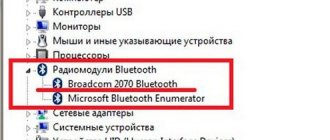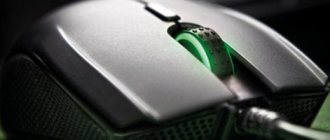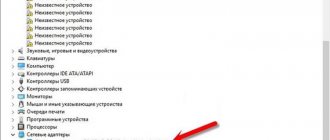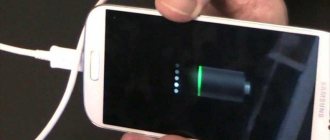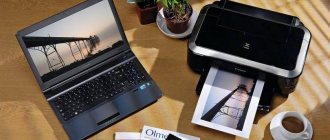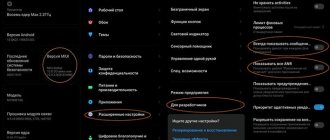04/13/2016 windows
If, when you connect something via USB in Windows 10 or Windows 8 (8.1) - a flash drive, phone, tablet, player or anything else (and sometimes just a USB cable), you see an Unknown USB device in the device manager and a message about “Device descriptor request failed” indicating error Code 43 (in properties), in this instruction I will try to give working ways to fix this error. Another variant of the same error is a port reset failure.
According to the specification, a failure to request a device descriptor or reset a port and error code 43 indicate that not everything is in order with the connection (physical) to the USB device, but in fact, this is not always the reason (but if something was done with ports on devices or there is a possibility of their contamination or oxidation, check this factor too, similarly - if you connect something via a USB hub, try connecting directly to the USB port). More often it’s a matter of installed Windows drivers or their incorrect operation, but we’ll consider all other options. The article may also be useful: USB device is not recognized in Windows
USB device descriptor request failed
Often a failure is accompanied by a “Code 43” notification. This indicates that the equipment is not working. The whole problem is in the USB architecture. This protocol is one of the most universal on the market. This is due to the presence of an expanded hierarchy - a set of descriptors. There are only 4 of them, and if one is faulty, then transmitting data through the port becomes impossible. In simple terms, descriptors can be called a description of the basic parameters of a device, for example, the need for current or channel capacity. Without such identifiers, Windows will not “figure out” what to do to “communicate” with the equipment.
What is this error
The “Device Descriptor Device Failure” notification pops up if the peripheral connected to the PC is not detected by the operating system (OS). Therefore you need to make sure of the following:
- the device connector is tightly inserted into the connector;
- the device is working properly – (checked when connecting to another computer, there should be no problems with the connection).
Checking power consumption and relieving static electricity
In the properties of the “USB Root Hub” on the “Power” tab, make sure that the power consumption does not exceed the permissible value. If such a problem exists, you need to completely turn off the computer:
- Disconnect all connected peripherals from the ports.
- Turn off the computer using the standard shutdown method, disconnect from the power supply (if you have a laptop, remove the battery).
- After turning off completely, press and hold the computer's start button for a few seconds.
- Connect the equipment to the power supply and turn it on.
- Connect the required peripherals one by one.
After starting the operating system, the problem should be resolved.
Reasons for USB Device Descriptor Request Failure
There are 2 categories of possible causes of the problem:
- Technical. Failure of equipment or a specific part of it. Device descriptor failure rarely occurs due to technical problems.
- Software. The problem is that the OS cannot “understand” why the connected peripherals are not detected. From the system's point of view, it is an unidentified device that cannot be used.
Technical problems
They make normal data transfer from the device to the PC impossible. This means that some contact has moved away, and only part of the descriptors is sent to the USB port. Typically, such failures are preceded by mechanical damage to the computer or peripherals. For example, a laptop fell off the bed, a flash drive was stepped on.
Viruses/malware
Often malware does not cause this problem for the following reasons:
- the inability to use a USB device is beneficial to attackers;
- The error message is generated by the OS because It is difficult to intentionally cause such a notification when the PC and the connected device are actually working.
Problems in the OS (drivers, etc.)
The most common reason. It occurs both directly with the driver and indirectly – as a result of incorrect OS settings. Also for USB 3.0 ports (they are colored blue inside) it is typical:
- lack of installed drivers;
- replacement with universal windows drivers.
Update Windows
If you receive error 43, it is important to make sure that the latest system updates are installed on your PC. Microsoft releases updates to improve system stability and fix various issues, including device connection errors.
Step 1. Press the “Win+I” keys and click “Update and Security”.
Click “Update and Security”
Step 2. Select “Update Center...” on the left and click “Check for updates” on the right. Existing files will be installed automatically.
Select “Update Center…” on the left and click “Check for updates” on the right
Step 3: Check if the mentioned problem still persists.
Read detailed information if Windows 10 is not updated in our new article.
Solutions to the problem
Below are ways to solve the problem: from the simplest and most effective to the rarer and more complex.
Equipment check
It is advisable to ensure the following:
- The specific USB port is working. To do this, a device is inserted into it, which works normally when connected to another port;
- the device connector is not physically damaged - there should be no bent or oxidized parts inside it;
- When connecting to ports located on the front side of the desktop computer case, it is advisable to check their serviceability (during assembly, they are connected separately to the motherboard).
OS and driver status
Troubleshooting a connection problem begins with the following steps:
- Hold down the Win+R key combination and enter the command devmgmt.msc, which is launched by pressing Enter. After this, “Device Manager” will open.
- Click on the line “USB Controllers”. A list of devices appears. If a yellow exclamation mark is displayed next to any of them, you need to highlight this line.
- Right-click – “Update drivers” => “Search for drivers...” => “Select from the list of already installed ones...”. There will likely only be one option in the list. You need to select it and click on “Next”.
- If in step 2 all the opened lines do not have color codes, you need to perform the actions from step 3 for all such devices: “Generic USB Hub”, “USB Root Hub”, “Composite USB Device”.
- Reboot the OS.
An alternative way is to clear all devices in the “USB Controllers” block and then reboot. To do this, in the “Properties” of the device you need to click “Delete” and confirm the operation. The next time you start the OS, it will install the missing drivers.
Another culprit may be uninstalled chipset drivers. In the “Device Manager” window there should be no lines with yellow or red icons at all. For example, if any of the following devices are displayed normally: Intel Chipset Driver, Intel Management Engine Interface, ACPI Driver, then there is no need to worry, otherwise you need to find all the missing drivers on unidentified hardware. To do this you need to perform the following manipulations:
- In the “Properties” of an unidentified device, go to the “Details” tab and select the “Equipment ID” value.
- Rows will be displayed in the “Value” block. In the first, you need to find a structure that begins with “VEN …” and copy it from this place to “… SUBSYS”.
- Next, the website opens. On the main page, in the “Vendor ID” field, enter 4 characters that appear in the previously copied structure after VEN, and in the “Device ID” - 4 characters after DEV. Then click on the search icon, and the site will provide information about the unknown device - manufacturer and exact model designation.
- Find this device in the driver network, download and install it. The result is that there will be no unknown equipment in the “Device Manager”.
You can also erase all information in the OS about previously connected USB devices. To do this you need to do the following:
- Run “Command Prompt” as administrator. In Windows 7 – “Start” => “All Programs” => “Accessories”. Find the “Command Prompt” line – right-click on it and select the “Run as...” option. In Windows 8 and later, enter the corresponding query in the system search, and, on the search result that appears, right-click and select the line “Run from...”.
- Copy the command set devmgr_show_nonpresent_devices=1 into the black window and press Enter. Do the same with the start devmgmt.msc command.
- In the upper corner of the “Device Manager” window, go to the “View” menu and activate the “Show hidden devices” option.
- Expand the “USB Controllers” list. Remove all devices with translucent font. Then delete all lines in “USB Root Hub”.
- Reboot the system.
Windows 10 USB device descriptor request failure may only appear when connected to a USB 3.0 port. This is a typical situation, since the modern version of the interface requires the installation of special drivers. For laptops, they can be found on the manufacturer’s website on the model page. For desktop computers, you need to find out the motherboard model and find the driver on the manufacturer’s website.
Check for Power Consumption and Relieve Static Voltage
The OS may be limiting the voltage supplied to the USB port. This feature exists to save battery power in laptops. To check the status of this option, you need to do this:
- In the “Device Manager” in the “USB Controllers” block, you need to right-click on one of the lines and click on “Properties” in the drop-down menu. Next, go to the “Management” tab.
- You need to find the line “Allow disabling...” and disable this option - uncheck it. Save changes by clicking “OK”.
- The previous step must be performed on all devices: “Generic USB Hub”, “USB Root Hub”, “Composite USB Device”.
To reset the static current, follow the following algorithm:
- Remove all connected devices from the USB connectors. Turn off the PC through the “start” menu by selecting “Shut down”. Disconnect it from the outlet. If the battery is removed from the laptop, it must be removed.
- Press and hold the PC power button for 10 seconds.
- They turn everything on again.
Disconnect the power supply from the laptop
Often, temporarily disconnecting the equipment from the power source will help resolve the handle request failure problem. Everything is extremely simple - disconnect the charging cable so that the laptop starts working from the built-in battery. After a few minutes, do the opposite - connect the charging cable.
Please note that this method will work for you if you are using a laptop rather than a desktop computer.
Didn't help, what next?
This means that this case is unique. The chance to fix the problem is minimal.
Reset BIOS settings to factory settings
The easiest way for desktop computer owners is to remove the side cover from the case, find the battery on the motherboard and pull it out for a couple of minutes. This is done with the equipment completely turned off.
Everything can also be done programmatically. To do this, perform the following actions:
- you need to go into BIOS;
- activate the option “Load Defaults BIOS” (“Load BIOS Setup Defaults”, “Load Safe-Fail Defaults”) - the inscription may differ.
Reinstalling the operating system
It happens that pirated OS builds contain internal errors that cause a problem with the device descriptor. Then the easiest way is to install another version of Windows. License holders can also try reinstalling, but this does not guarantee that the problem will be resolved.
Run a full system scan
Malware, among other problems, can cause hardware connection errors.
You need to run a full system scan to try to detect malware on your PC. You can use the built-in Windows Defender or third-party antivirus programs.
An example of running a full system scan with standalone Windows Defender running separately from the operating system.
Step 1: Press “Win+I” and click “Update and Security.”
Click “Update and Security”
Step 2. Select “Windows Defender” on the left and click “Scan offline” on the right.
Select “Windows Defender” on the left and click “Scan offline” on the right
Step 3. Click “Check” to confirm the OS restart.
Click “Check”
Wait for the defender to load and finish scanning the system for malware.
Step 4: Check if the error is resolved.
Download
Now you can proceed to downloading the software.
| Developer: | IObit |
| Release year: | 2022 |
| Name: | Driver Booster |
| Platform: | Microsoft Windows 10 x64 Bit |
| Language: | Russian |
| License: | Crack included |
| Archive password: | bestsoft.club |
USB device descriptor failure Windows 10 x64 Bit
Drivers: updating!
In other words, we avoid usb device descriptor errors in Windows 10 - after doing all of the above or partially and not coming to a result, think about it. Why could a suddenly unknown, but hitherto very well-known device appear? Apparently it’s worth updating the drivers, we’ll tell you how to do it correctly. Again, we will reinstall for all categories, as with power management.
- Go to “Device Manager” - the methods are described above
- “USB Controllers” → PCM “Root USB-con”
- "Search for drivers on this computer"
- “Select a driver from the list of already installed ones” → “Next”
- The driver “Root USB...” must be specified, see the screenshot for details → “Next” → Installed successfully
If the error is resolved and the “Unknown Device” is no longer in the list, you can not update the remaining drivers.
Restore the operating system
If the user made any changes to the operating system before receiving error 43, you can restore the system to a pre-error state to resolve the issue.
Step 1. Press “Win+R”, type “sysdm.cpl” and click “OK”.
Press “Win+R”, type “sysdm.cpl” and click “OK”
Step 2. Open the “System Protection” tab and click “Restore”.
Open the “System Protection” tab and click “Restore”
Step 3 : Click Next.
Click “Next”
Step 4. Select a save point with a date before the specified error occurred, and click “Next”.
Select a save point with a date before the specified error occurred, and click “Next”
Step 5. Click "Done".
Click “Finish”
Step 6. Click "Yes".
Click “Yes”
After Windows automatically restarts, it will begin to restore its previous state.
We are waiting for Windows to be restored to its previous state.
Step 7. After restoring the system, check if the problem is resolved.
Click “Close”, check the device that gives the error
